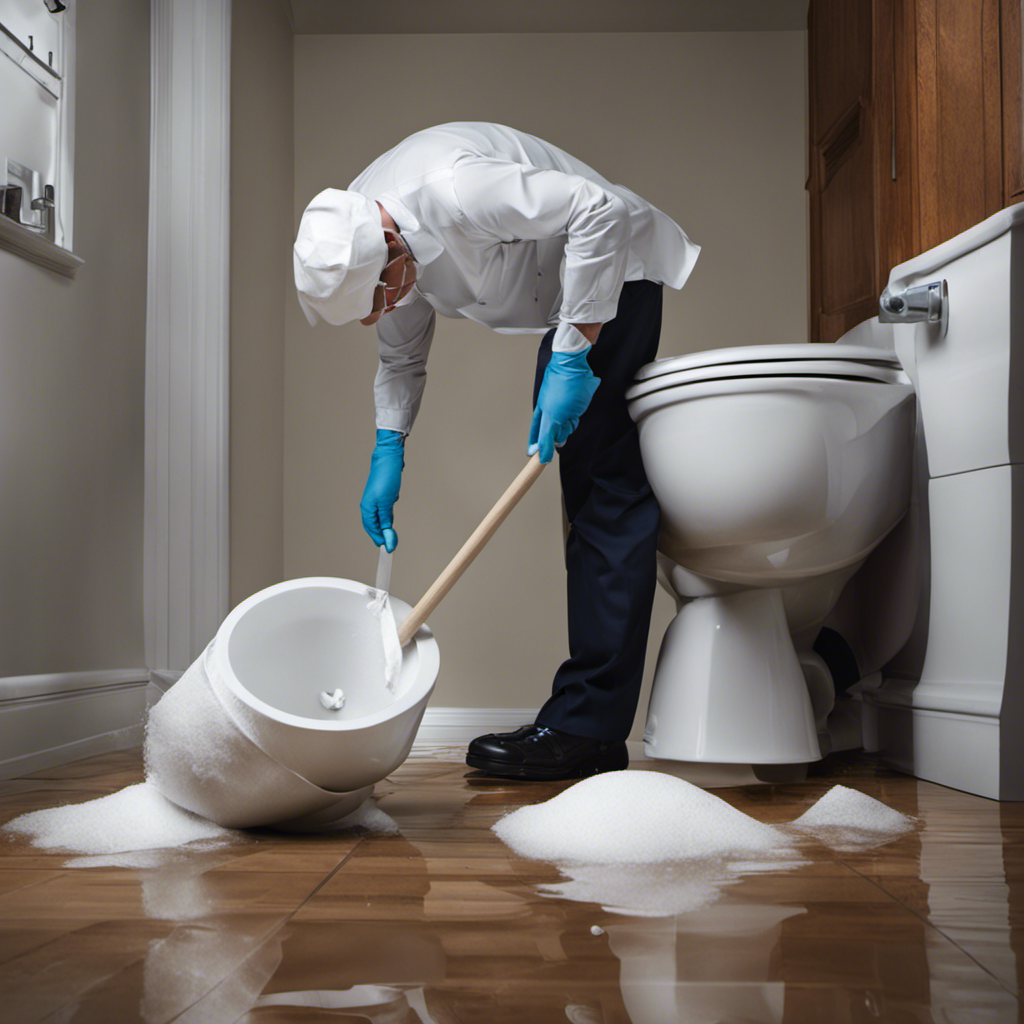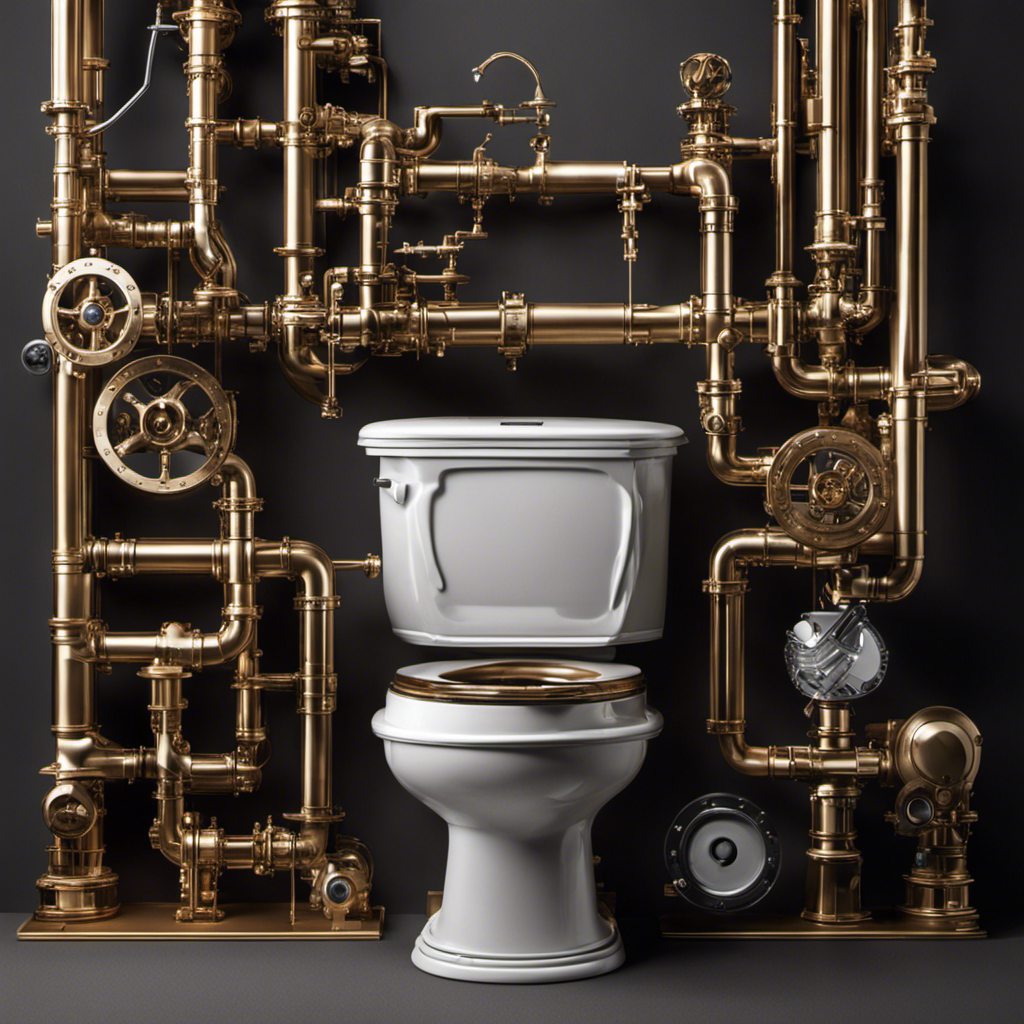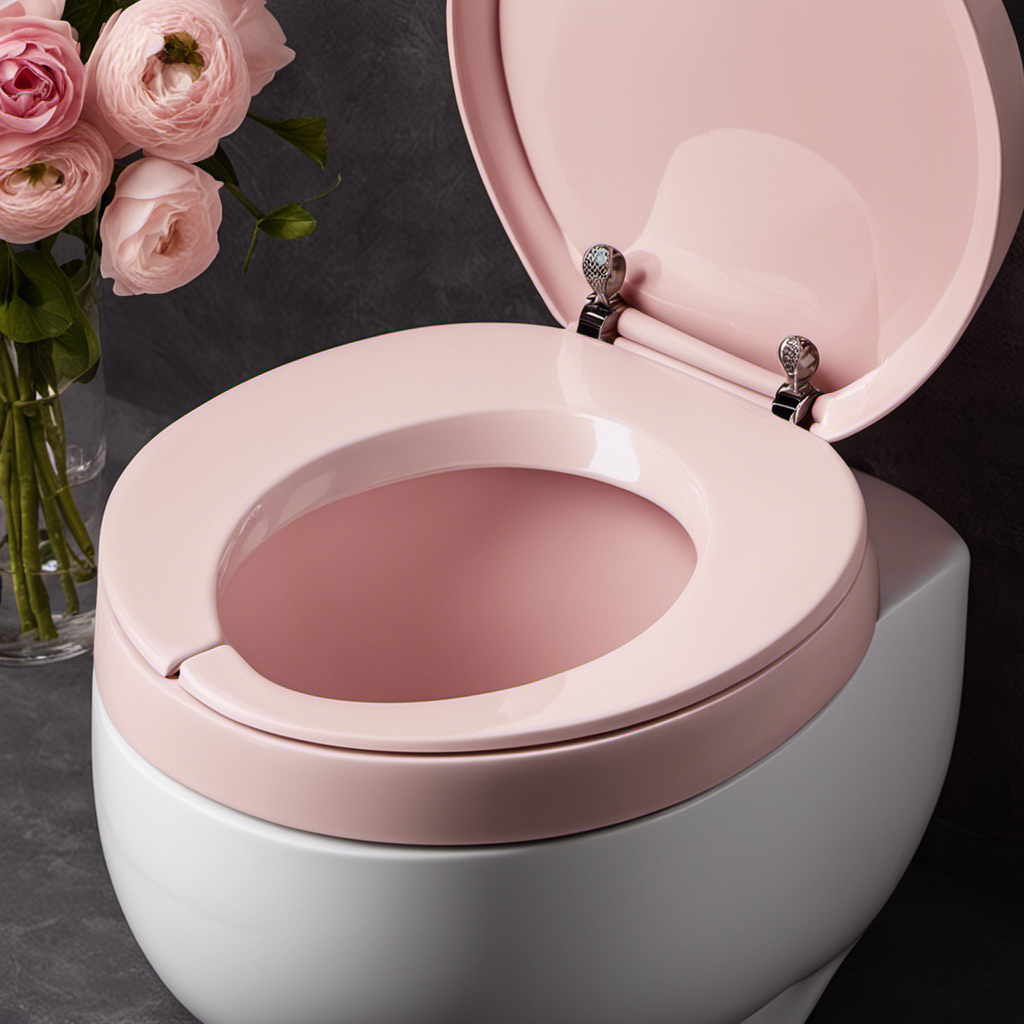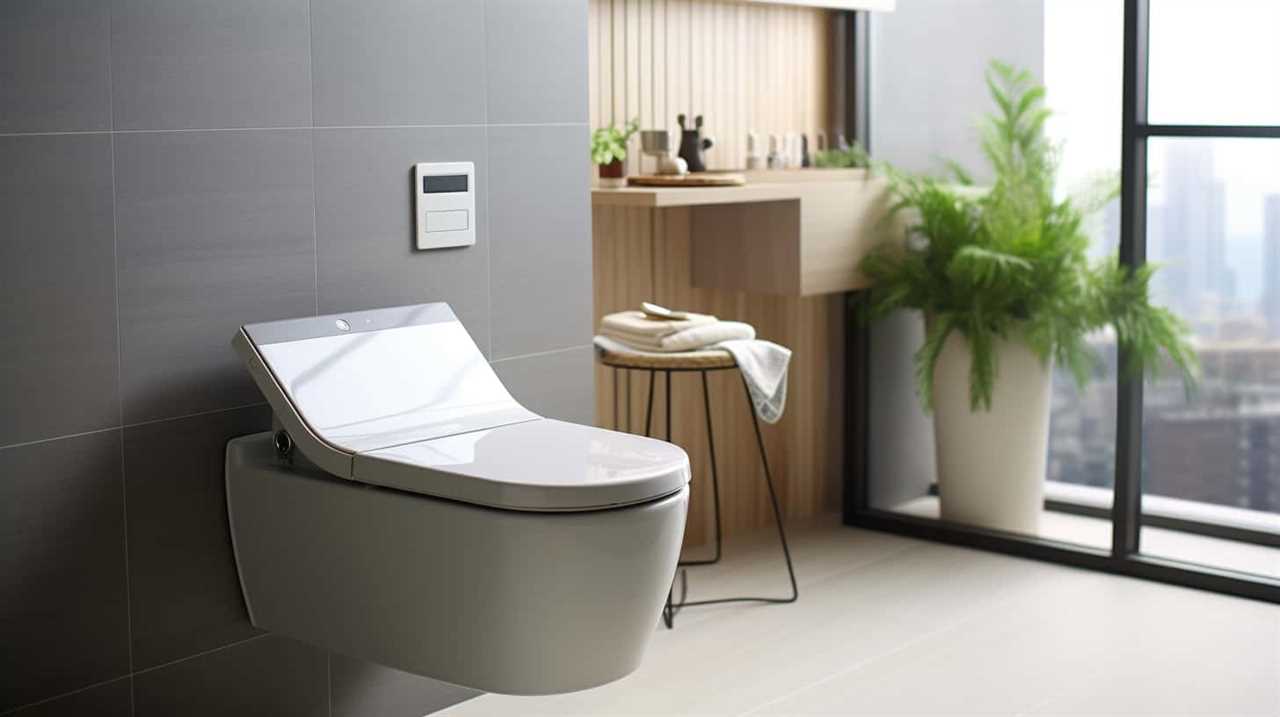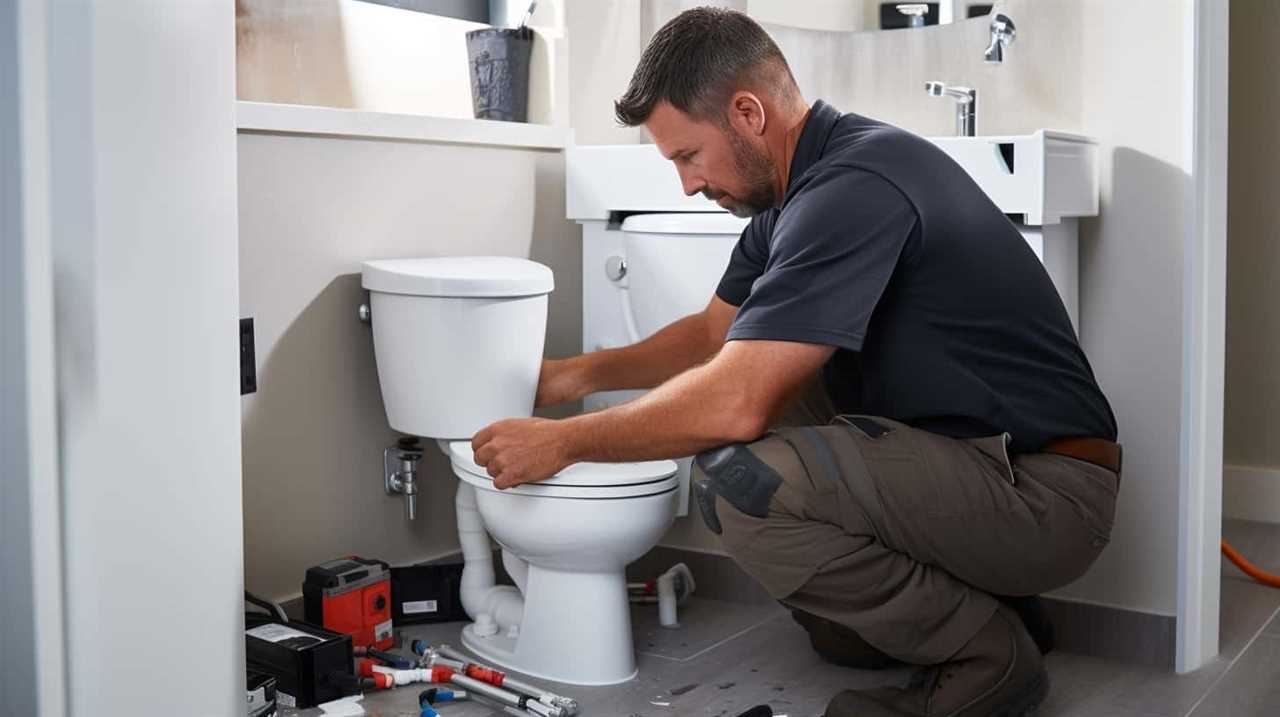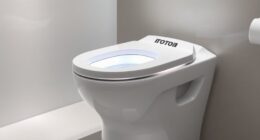Oh no, not again! There’s nothing quite like the panic of a clogged toilet. But fear not, because I’m here to guide you through the steps of unclogging it.
In this article, I’ll explain the common causes of toilet clogs, the tools and supplies you’ll need, and provide you with a step-by-step guide to tackle the problem head-on.
I’ll also share some tips to prevent future clogs and let you know when it’s time to call in a professional plumber.
So let’s dive in and bid farewell to that stubborn clog!
Key Takeaways
- Flushing excessive amounts of toilet paper can overwhelm the system and lead to clogs.
- Using thinner, easily dissolvable toilet paper can reduce the risk of clogs.
- Plunging and snaking are effective techniques for unclogging a toilet.
- Regular toilet cleaning and maintenance are important for preventing clogs.
Common Causes of Toilet Clogs
One of the most common causes of toilet clogs is flushing excessive amounts of toilet paper. It’s important to remember that toilets are designed to handle a certain amount of paper at a time. Flushing large quantities of toilet paper can overwhelm the system and lead to clogs.
To prevent toilet clogs, it’s recommended to use only a reasonable amount of toilet paper per flush. You can also consider using thinner, more easily dissolvable toilet paper to reduce the risk of clogs.
Signs of a clogged toilet include water rising to the brim when flushing, slow drainage, or gurgling sounds. If you notice any of these signs, it’s best to address the issue promptly to avoid further complications.
Tools and Supplies You’ll Need
When it comes to dealing with plumbing issues, having the right tools is essential. In this discussion, I will explain the essential plumbing tools that every DIYer should have in their toolbox.
Additionally, I will provide detailed explanations of various unclogging techniques and the common supplies you’ll need for DIY plumbing projects.
Essential Plumbing Tools
To fix a clogged toilet, you’ll need a plunger and a snake. These two plumbing equipment are essential for any toilet repair.
The plunger is a tool used to create suction and force out any blockages in the toilet drain. It works by covering the drain opening and pushing and pulling the handle to create pressure.
The snake, also known as a toilet auger, is used for more stubborn clogs that the plunger can’t handle. It is a long, flexible tool that can reach deep into the toilet drain to break up and remove the blockage.
When using these tools, it’s important to follow the correct procedures and techniques to avoid causing further damage.
Unclogging Techniques Explained
Make sure you have a plunger and a snake handy to effectively clear any blockages in your toilet drain. Toilet cleaning and maintenance are essential tasks to keep your bathroom in good working order. When faced with a clogged toilet, it’s important to know the right techniques to unclog it. Here are some methods you can try:
| Technique | Steps |
|---|---|
| Plunging | 1. Position the plunger over the drain. |
- Push down firmly and then pull up quickly.
- Repeat until the water drains. |
| Snaking | 1. Insert the snake into the drain. - Rotate the snake to break up the clog.
- Pull out the snake and flush the toilet to check for clearance. |
Common Supplies for DIY
Having the right supplies on hand is essential for your DIY plumbing projects.
When it comes to unclogging a toilet, there are a few key items you should have in your toolbox. First and foremost, a high-quality plunger is a must-have. Look for one with a flange or an accordion-style design for maximum effectiveness.
Another useful tool is a toilet auger or snake, which can help break up stubborn clogs that the plunger can’t handle.
Additionally, having a pair of rubber gloves and a bucket nearby is important for containing any mess that may occur during the unclogging process.
Remember to never use harsh chemicals, as they can damage your plumbing system.
With these supplies on hand, you’ll be well-prepared to tackle any toilet clog that comes your way.
Step-by-Step Guide to Unclogging a Toilet
First, you’re going to need a plunger to unclog the toilet. Here’s a step-by-step guide to help you get the job done:
- Make sure you have a toilet plunger with a flange, as it provides a better seal and more effective plunging.
- Fill the toilet bowl with enough water to cover the rubber cup of the plunger.
- If you don’t have a plunger, you can try using a wire hanger or a toilet auger as alternative methods.
- Another option is to pour hot water into the toilet bowl and let it sit for a few minutes before attempting to plunge.
Once you have the plunger ready, follow these steps:
- Place the plunger over the drain hole in the toilet bowl.
- Press down firmly and then pull up quickly, creating suction.
- Repeat this plunging motion several times until the water starts to drain.
By following these steps, you should be able to unclog your toilet successfully.
Now, let’s move on to some tips for preventing future toilet clogs.
Tips for Preventing Future Toilet Clogs
To prevent future clogs, you should regularly use a toilet brush to keep the bowl clean. Toilet maintenance is crucial in avoiding plumbing issues.
Besides using a brush, it’s important to use proper flushing techniques. When flushing, make sure to hold down the handle until all waste is gone and the water has fully replenished. Avoid flushing excessive amounts of toilet paper or anything else that could potentially clog the pipes.
Additionally, be mindful of what you flush down the toilet. Items like wipes, paper towels, or feminine hygiene products should never be flushed, as they can easily cause clogs.
When to Call a Professional Plumber
If you’re experiencing persistent plumbing issues, it may be time to call a professional plumber. While some minor clogs can be resolved with simple DIY methods, there are certain signs that indicate a more serious clog that requires professional attention.
Here’s when you should consider calling a plumber:
-
When to DIY:
-
If the clog is minor and can be easily solved with a plunger or a drain snake.
-
If you have experience and knowledge in handling plumbing issues.
-
Signs of a serious clog:
-
Multiple drains in your house are backed up at the same time.
-
Water is slow to drain or doesn’t drain at all.
-
Unpleasant odors are coming from your drains.
Troubleshooting Other Toilet Issues
When troubleshooting other issues with your toilet, start by checking the water level in the tank. Low water levels can indicate a problem with the fill valve or a clog in the water supply line.
If the water level is too high, it could be a sign of a faulty float valve or a problem with the flapper.
Another common problem is a leaking toilet tank. This can be caused by a cracked tank or a faulty flush valve. To fix this, you may need to replace the tank or the valve.
Additionally, toilet bowl stains can be a frustrating issue. They are often caused by hard water or mineral deposits. To remove these stains, you can try using a toilet bowl cleaner or a mixture of vinegar and water.
Conclusion
In conclusion, dealing with a clogged toilet can be a messy and frustrating experience. However, with the right tools and knowledge, it can be easily resolved.
By following the step-by-step guide and using the necessary tools, you can successfully unclog your toilet and prevent future clogs.
Remember, prevention is key, so make sure to avoid flushing items that can cause blockages.
If all else fails, don’t hesitate to call a professional plumber for assistance.
With these solutions in mind, you’ll be able to handle any toilet issue with confidence and ease.
